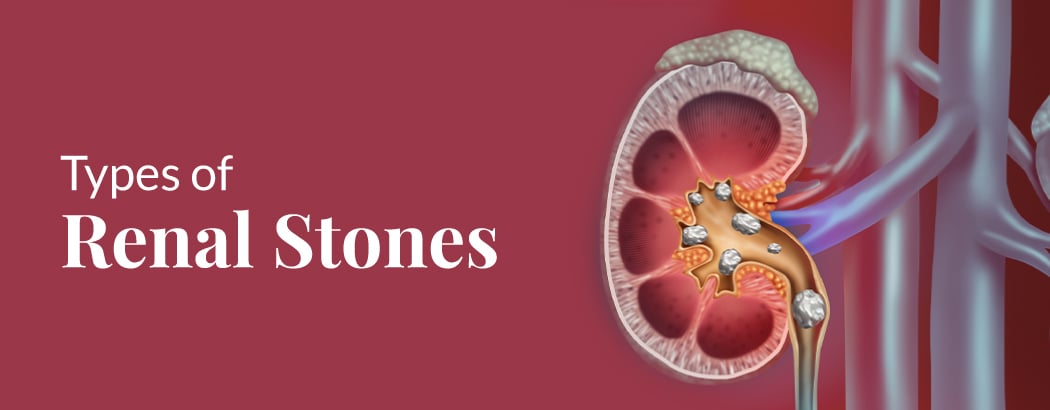Types of Renal Stones
December 11, 2023

Types of Renal Stones
Renal stones, also known as kidney stones, are solid deposits made up of tiny crystals that form from certain chemicals in the urine, inside the kidney. Passing through the urinary tract, they can cause pain but typically don’t result in permanent damage.
Renal stones, also known as renal calculi, nephrolithiasis, or urolithiasis, are a common medical condition with over a million cases reported annually in India. It is estimated that one in ten people will have a kidney stone at some time in their lives.
Contents
Lifecycle of a Renal Stone
The first stage is when the stone is formed in the kidney. Urine contains several waste materials that are dissolved in it. When there is an excess of waste in a limited amount of liquid, crystals start forming. These crystals attract other elements and combine to form a solid that can get bigger unless it is passed out of the body through urine. These crystals can develop into stones over weeks or months. Normally, the body’s master chemist, the kidney, eliminates these chemicals in urine. For most individuals, having enough water helps to wash out these chemicals and some other substances in urine prevent the formation of stones. The chemicals that lead to stone formation are calcium, oxalate, urate, cystine, xanthine, and phosphate.
The second stage is after the stone is formed, it may remain in the kidney or move down the urinary tract into the ureter, the tube connecting the kidney to the bladder.
The third stage is when the stone enters the bladder.
And finally, in the fourth stage, the stone is passed out of the body through urine. Sometimes, tiny stones pass out of the body in the urine without causing significant pain. However, stones that don’t move can cause a build-up of urine in the kidney, ureter, bladder, or urethra, leading to pain.
Different kinds of Renal Stones
With distinct causes, there are five primary types. A person’s diet and family history may put them at risk for developing specific types of renal stones.
- Calcium Stones – Calcium Oxalate Stones, Calcium Phosphate Stones
- Struvite Stones
- Uric Acid Stones
- Cystine Stones
Calcium Stones
Renal stones most commonly occur as calcium stones. They are composed of calcium salts, such as calcium phosphate and calcium oxalate. The risk of developing calcium stones is increased in individuals with high blood levels of oxalate and calcium.
Hyperparathyroidism is one of the medical disorders that can cause elevated calcium levels. The most prevalent type of renal stones are calcium ones, which are further separated into two subgroups according to the molecules that make them up:
- Calcium oxalate
- Calcium phosphate
The consumption of food-based calcium does not raise the risk of developing calcium oxalate stones. Extra calcium that is not needed by your bones, muscles, or kidneys typically ends up in your urine. Failure to do so results in the calcium remaining in the kidneys where it combines with other waste materials to form renal stones. Calcium stones contribute to 80% of renal stones.
Calcium Oxalate Stones
Compared to calcium phosphate stones, calcium oxalate stones are more prevalent. Calcium oxalate renal stones are the most prevalent type of renal stones. They are envelope or dumb bell-shaped. These happen when there are low citrate levels, high calcium levels, and either oxalate or uric acid levels in the urine. Natural oxalate occurs in plants and animals and is linked to the development of calcium oxalate stones. Many of the foods in our diets contain oxalate. The primary food sources of oxalate include:
- spinach and other green, leafy vegetables
- rhubarb
- wheat bran
- almonds
- beets
- navy beans
- chocolate
- okra
- french fries and baked potatoes
- nuts and seeds
- soy products
- tea
- strawberries and raspberries
Your GI(gastrointestinal) tract breaks down these foods and absorbs the nutrients when you eat them. The residual wastes then make their way to your kidneys, where they are eliminated into your urine. Oxalic acid is the byproduct of oxalate degradation. In the urine, it can react with calcium to form calcium oxalate crystals.
Calcium Phosphate Stones
A different type of calcium stone called calcium phosphate stones is far less common than calcium oxalate stones. Renal tubular acidosis is a disease that causes calcium phosphate stones in certain individuals. These types of renal stones are amorphous or rose-shaped rosettes in appearance. Deviations in the urinary system’s normal operation are the cause of calcium phosphate renal stones. This kind of stone, which frequently develops concurrently with calcium oxalate stones, may be caused by kidney or urinary issues. Your doctor may order a battery of blood and urine tests to investigate this possibility.
Struvite Stones
Your kidneys may develop a hard mineral deposit called struvite stones. When minerals in your kidneys crystallize and adhere to one another, such as calcium and phosphate, stones can develop. Bacteria in your urinary tract produce the mineral struvite. Struvite stones are more common in women and are caused by specific kinds of UTIs.
Struvite is the primary component of 10–15% of kidney stones which are coffin-lid shaped stones.
Stones with struvite frequently enlarge and grow quickly, sometimes taking up the entire kidney. They have the potential to eventually damage your kidney by blocking your ureter, bladder, or kidney. These stones, if left untreated, can result in kidney failure and recurrent, occasionally severe urinary tract infections.
Uric Acid Stones
Uric acid stones are the type of renal stones which are more common in men and usually result from a diet high in animal protein or from dehydration. Additionally, those who have had chemotherapy, had gout or had a family history of this type of renal stone are more likely to experience them. Uric acid stones are rhomboid-shaped stones and make up for up to 5 – 10 % of renal stones. The following are some things that can make this kind of kidney stone more likely:
- Low urine output
- Health conditions like gout and Crohn’s disease
- Increased alcohol intake
- A diet high in animal protein, such as meat, eggs and fish
Cystine Stones
These types of renal stones are quite uncommon and typically run in families. Cystine stones contribute to only 1% of renal stones. “Cystinuria” is a rare disorder that causes cystine stones. The condition results in the natural substance “cystine” leaking into your urine. Renal stones may develop when the urine contains an excessive amount of cystine. Anywhere in the urinary tract, including the kidneys and bladder can become blocked by these stones. The majority of cystinurics experience recurrent stones. It is a chronic illness that has management potential but no cure. Cystine stones are usually hexagon shaped.
Conclusion
Most types of renal stones are painful, but most of the time they can be removed from the body without causing lasting damage. Renal stones often come back. This occurs more often if the cause still needs to be found and treated. One is at risk for urinary tract infection, kidney damage, or scarring if treatment is delayed for too long.
Frequently Asked Questions
1. Can renal stones be cured?
Surgery is not always necessary to treat renal stones. In three to six weeks, the majority of stones will naturally disappear. Pain relief is the only necessary treatment in this case. But sometimes the pain can be so bad that a hospital stay and very potent painkillers are required.
2. Can children get renal stones?
Renal stones can occur in children of any age, even in newborns, but they are far more common in teenagers. A child is more likely to get renal stones if they have a family history of the condition. Children who have previously experienced renal stones are more likely to experience renal stones again.
3. Is it okay to leave renal stones untreated?
Renal stones can narrow or obstruct the ureters if they are not treated. Urine may accumulate as a result, increasing the risk of infection and straining the kidneys. Since most renal stones are treated before they can cause complications, these issues are uncommon.
4. Which doctor should I see in case of experiencing any symptoms related to types of renal stones?
A simple visit to a urologist may be sufficient when the stones are small and self-passing. Emergency assistance may be necessary if they are large and refuse to pass. A urologist has a specialization in diagnosing and treating disorders related to the urinary system such as kidneys, ureters, bladder, prostate, and male reproductive organs.








